10 Types of Drills and When to Use Each
Find out more about these 10 common types of drills
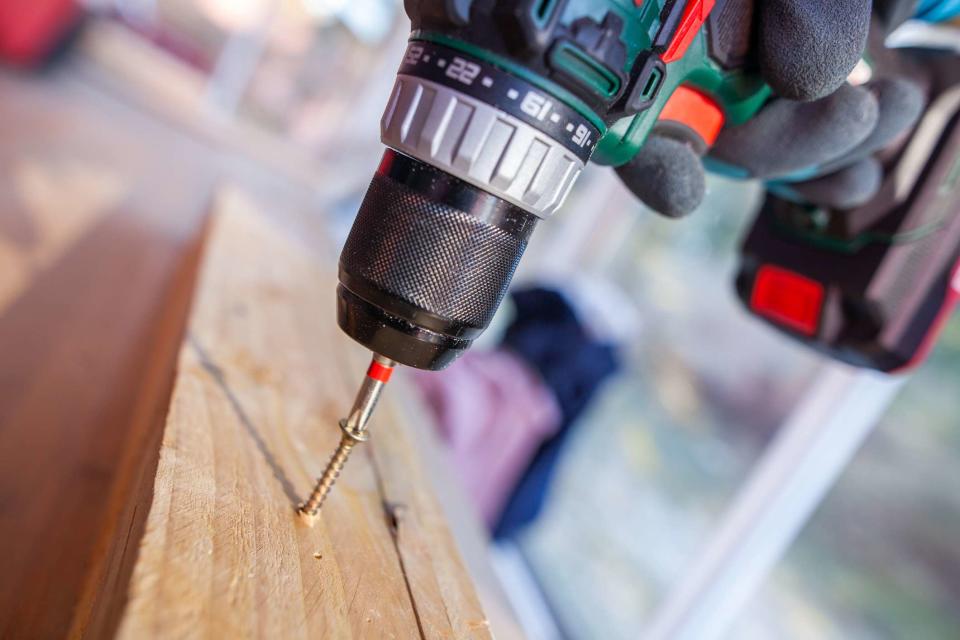
Capelle.r / Getty Images
Reviewed by Deane Biermeier
Drills are tools used to make round holes in a material, like wood, or for driving fasteners, like screws. The most common type of drills accomplish this task by rotating the equipped drill or driver bit at high speeds when the user squeezes the trigger. These tools can be manual, corded, battery-powered, or pneumatic, and they are widely used in many professional industries.
Carpenters, electricians, auto mechanics, and even plumbers typically have a drill on hand because these power tools are so versatile. Most DIYers have at least one drill around the home for various tasks, like hanging a TV or running wires. You can find specialized drills designed for making circular holes or drilling through different materials; however, a combination drill driver is usually the most beneficial for a DIYer.
Check out this guide to learn more about these 10 types of drills and how to choose.
The 12 Best Cordless Drills of 2023, Tested and Reviewed
Drill Features to Consider
Many drills have similar features, whether you decide on a corded, battery-powered, or pneumatic drill. These are the different parts of a drill:
Ratcheting and non-racheting chuck: This part holds the drill bit. Older chucks had to be tightened with a key (which was easy to lose), but most of today’s chucks can be hand-tightened. Just slip in the bit and start drilling. Rotate the chuck at the front of the tool clockwise. This opens it up while turning it counterclockwise closes it. Inside, metal prongs (usually three) extend outward as they close. These prongs grab your bit securely when you tighten the chuck.
Jaw: The prongs or part of the chuck that tightens onto the bit. Drills vary on how reliably the jaws hold the bit.
Rocker switch: Switch the chuck from forward (clockwise rotation) to reverse (counterclockwise).
Trigger: Controls the drill and gives more or less power based on how much you squeeze the trigger.
Motor: Many new cordless drills offer brushed or brushless motors. Brushless motors have torque, use less power, and allow for a more compact design. Corded drills have more powerful motors than cordless to do more complex jobs.
Variable speed reversing: This feature is standard on most drills, controlling the drill rotation speed with a separate button for reversing rotation. This feature is handy for backing out screws and pulling out a bit when done.
Gear switch: You’ll usually find the control on the top of your drill can switch gears. You get the most torque at low speed. Most have two speeds, but others may have four.
Clutch collar: Select lower torque settings to activate a clutch. It lets you stop the bit from rotating too hard or fast.
Auxiliary handle: This additional handle extends perpendicularly from the drill body on powerful drills for tough work, like drilling concrete.
LED guide light: An LED guide light is usually a standard feature on cordless drills.
How to Insert a Drill Bit
To insert the drill bit, slide it into the chuck, hold it in the center, and twist the collar counterclockwise until it clamps. If it has a ratcheting function, you can feel and hear it clamping tight. If the bit has a significant wobble, it might be off-center. Loosen the chuck, re-center the bit, and tighten it to fix it.
Hand or Manual Drill
A hand drill is a manual, non-powered drill called a brace-and-bit or gear-driven drill. These drills can be used for lighter jobs. More efficient and easier-to-use power drills tackle most jobs now, but people who work with jewelry and circuit boards still need the accuracy and responsiveness of a hand drill. Hobbyists or circuit tinkerers favor the Mudder Hand Drill, which is highly rated for precision use. It comes with a wide selection of bits for multiple purposes.
Drill Driver
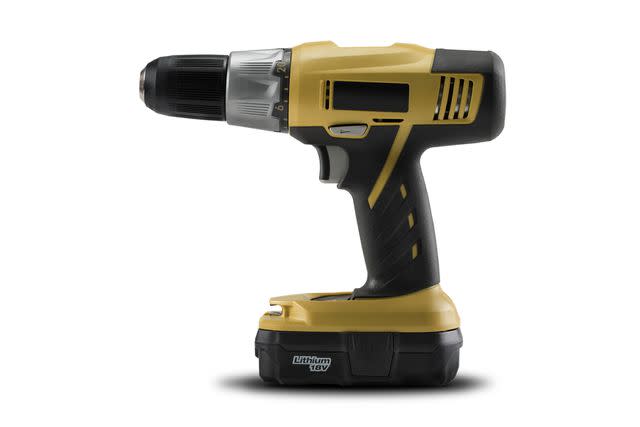
Yuri Kriventsoff / Getty Images
Best For: Driving fasteners and drilling holes in wood, plastic, and thin metals
Drill drivers are the most common type of drill for a DIYer because these combination drills are designed with a standard drill function to drill holes and a driver function to tighten or loosen fasteners.
The standard drill setting rotates the drill bit at high speed to drill holes through wood, metal, and other materials, while the driver setting slows the rate of rotation and increases the torque to drive fasteners like screws and bolts.
This type of drill has corded electric, battery-powered, or pneumatic models so that you can choose the right drill driver based on your needs. If you only have one type of drill at home, it's recommended to have a drill driver due to the sheer versatility of the tool for DIY repairs and renovations.
Tip
Keep two hands on the tool when drilling a hole for better control. When drilling in metal, use a few drops of oil to reduce friction and heat and extend the drill bit's life.
Hammer Drill
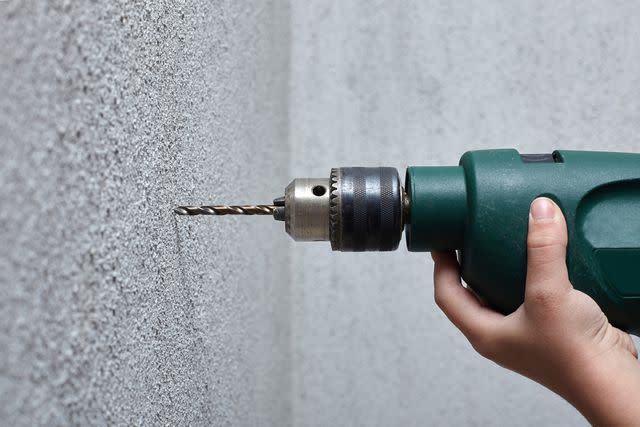
Marinos Karafyllidis / 500px / Getty Images
Best For: Applying concussive force to drill through masonry materials
A hammer drill combines rotational and concussive forces to drill through various masonry materials. The rotational force of a standard drill is not enough to drill through rigid materials like brick and mortar, so hammer drills also have a hammering mechanism that repeatedly drives the head of the drill bit against the target material while the drill bit is rapidly rotating.
Many hammer drills can also be set to standard drill or even driver modes, allowing you to use them for various tasks. However, it's important to mention that you will need a masonry drill bit if you are drilling through masonry materials with a hammer drill. A standard wood drill bit would chip and likely break due to the concussive force.
Rotary Hammer Drill
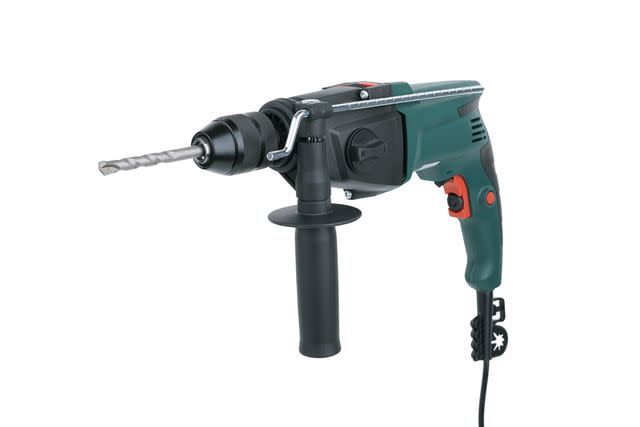
Yevgen Romanenko / Getty Images
Best For: Heavy-duty drilling through brick, concrete, or even rock
A step up from the hammer drill is the rotary hammer drill, which combines the rotational power of a hammer drill with extreme concussive force, akin to a small jackhammer. These drills are used for various jobs, like running water lines through the foundation of a new home. The average DIYer won't use a rotary hammer drill much, though they are prevalent in several professions.
If you need a rotary hammer drill for a project around the home, it's recommended to rent one from a local home improvement or tool rental depot instead of spending the money to purchase this specialized device.
Impact Driver
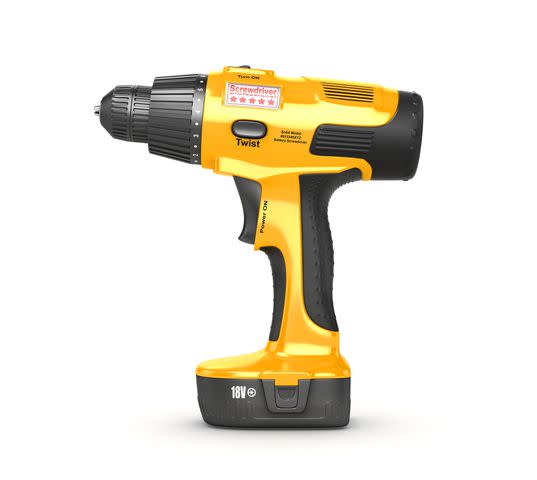
urfinguss / Getty Images
Best For: Driving fasteners in tight spaces
The impact driver is a compact tool that is intended for driving screws and other fasteners. The handle and trigger are essentially the same as a drill driver, but the body is short, allowing the impact driver to fit into areas a typical drill driver might not reach.
These often battery-powered tools prioritize torque over speed, which makes them ideal for driving or removing long, thick screws and bolts. They're also available in pneumatic and corded versions. Impact drivers have limited use for drilling holes. It's better to rely on a standard drill or drill driver for most situations where a drill hole is required.
Drywall Screwgun
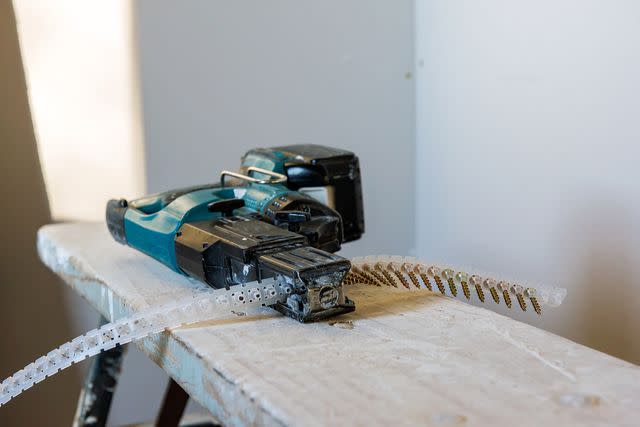
tracielouise / Getty Images
Best For: Securing drywall sheets to studs
As the name indicates, drywall screwguns are specialized tools for installing drywall panels. These battery-powered or corded tools offer mobility and speed, allowing drywall installers to quickly secure drywall panels by driving drywall screws through the drywall and into the wall studs.
Drywall screw guns are narrow, lightweight tools that operate essentially the same as an impact driver. However, they typically have an adjustable depth gauge to keep the screws from penetrating too far into the drywall. Many models come equipped for use with collated drywall screws for even faster installation.
Ground Auger
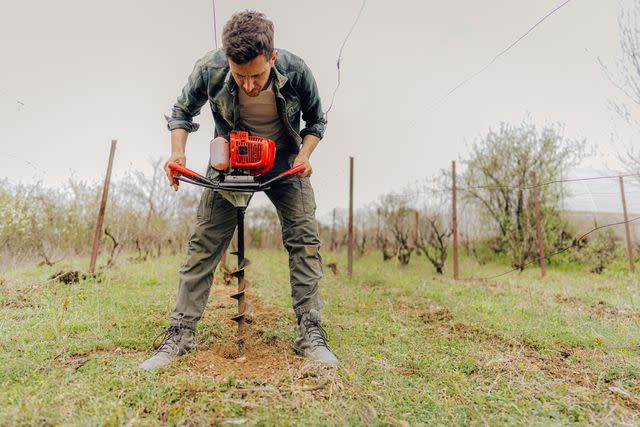
AleksandarNakic / Getty Images
Best For: Boring holes in the ground
A ground auger is intended for digging holes into the dirt, allowing you to install fence posts or cultivate the soil for planting vegetables, flowers, or other vegetation. These tools are called post-hole augers, earth augers, or earth drills.
While you can purchase a ground auger for the home, it isn't usually worth the costly investment if you only use it once every so often to install or replace fence posts. Instead, rent a ground auger for a short period to complete your project and save some money.
Right-Angle Drill Driver
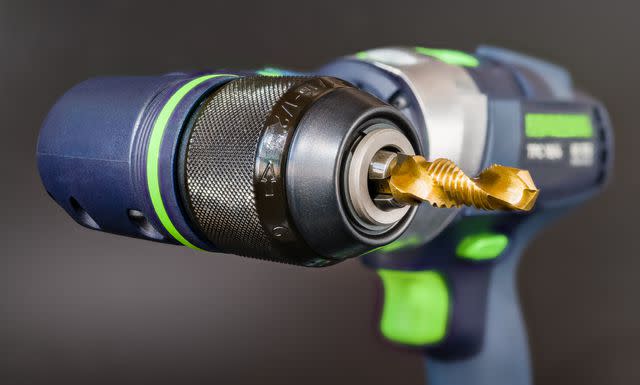
Ladislav Kubeš / Getty Images
Best For: Drilling or driving in very narrow spaces
Right-angle drill drivers have a long, thin handle that extends to the small, perpendicular head where the bits are held. A right-angle drill driver is an excellent option if you are working in a tight location, like under the sink or up in the ceiling. These tools are made for convenience and mobility, so they are typically battery-powered.
Use a right-angle drill driver to drive fasteners when there isn't enough space for an impact driver, or you can use this tool to drill small holes in wood or thin metal. However, right-angle drill drivers are not designed for power, so if you find the tool lacking, you may need to switch to a more powerful drill to finish the job.
Electric Screwdriver
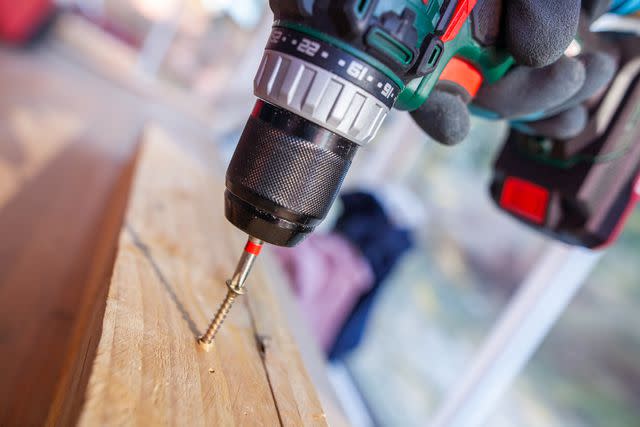
Capelle.r / Getty Images
Best For: Tightening or loosening screws and other fasteners
Electric screwdrivers fall into the drill category because of the powered rotational force used to drive screws. These portable tools often have a built-in battery that needs to be charged before the screwdriver can be used. Once charged, the screwdriver tip will rotate to drive screws and other suitable fasteners, depending on the bit.
You can use an electric screwdriver instead of a regular screwdriver to save time and effort. They are also great options for working in tight spaces where a standard drill driver or impact driver would have difficulty accessing, such as inside the ceiling or behind a wall.
Tip
Pause working with a tool if it or the battery gets hot. Allow the device to cool down to prevent damaging the motor or battery.
Pneumatic Drill
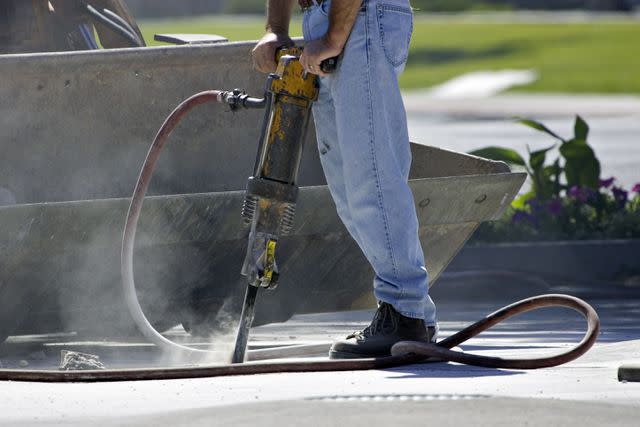
BirdofPrey / Getty Images
Best For: Compressed air-driven drilling
A pneumatic drill uses compressed air to drive the drill gears instead of relying on battery power or electricity from an extension cord. To use a pneumatic drill, connect it to an air compressor or a built-in pneumatic system.
Pneumatic drills are more common in commercial and industrial workshops because these businesses usually have built-in pneumatic systems to power multiple pneumatic tools. However, this isn't to say that DIYers cannot use pneumatic drills. In your workshop, you would need a home air compressor or a small pneumatic system to power a pneumatic drill effectively.
Drill Press
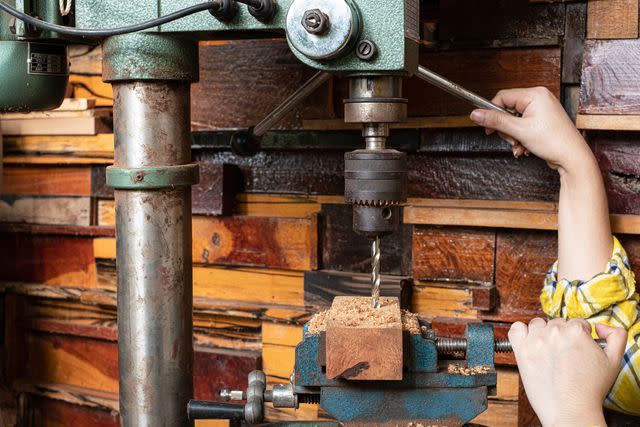
Chonticha Vatpongpee / EyeEm / Getty Images
Best For: Precise stationary drilling through wood, metal, and other materials
A drill press is a stationary power tool common in woodworking and metalworking shops. It has a large body hangs over the top of a built-in table where the target material can be clamped to prevent it from moving while you work.
The drill bit plunges vertically down through the material to drill highly accurate holes that are difficult to achieve with a handheld drill. Not only are the drill holes accurate, but they are also repeatable. So, you can drill the same hole in the same location on several different pieces of wood or metal without needing to readjust the position of the drill bit.
Choosing a Drill
Various drills are designed with strengths to help the user accomplish a specific task. With this in mind, you must clearly understand what you must achieve before selecting the right drill for your next project.
A drill press is an excellent option if you need precise drill holes, but if the material is too big to put onto the drill press table, you may need to rely on a handheld drill or drill driver to get the job done.
Some drills, such as a ground auger, are highly specialized, so you may not need to own them. Rent the tool from a local home improvement store to dig any fence posts you need, then return the tool when you are finished.
Pneumatic drills are typically used in industrial and commercial workshops. If you have several pneumatic tools, investing in a pneumatic system for your home workshop may be worth it. Consider the list of drill types above and select the drill that best suits your needs.
Frequently Asked Questions
How many categories of drills are there?
There are three main categories of drills, with at least a dozen or more types of drills that fall within these groups: traditional drill, impact driver, and hammer drill. Traditional drills are general use. Impact drivers are used for heavy-duty screw tightening, while hammer drills require two hands and are used for drilling into concrete and masonry.
What are the strongest drill bits?
Carbide bits are the strongest drill bits, able to cut through hardened steel. Next are titanium and cobalt drill bits.
What drill bit is the best for drilling into wood?
Use a brad point drill bit to make a clean, straight, accurate-sized wood hole in hard or softwood. The drill bit comes equipped with a center screw.
Read Next: How to Drill Into Brick
Read the original article on The Spruce.

